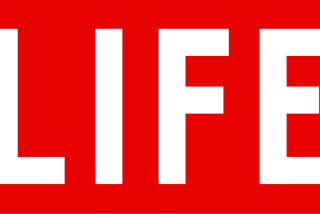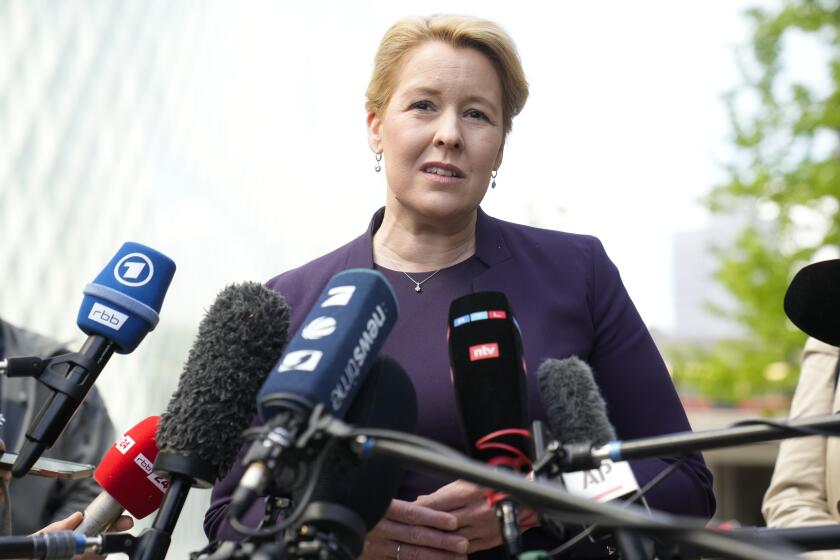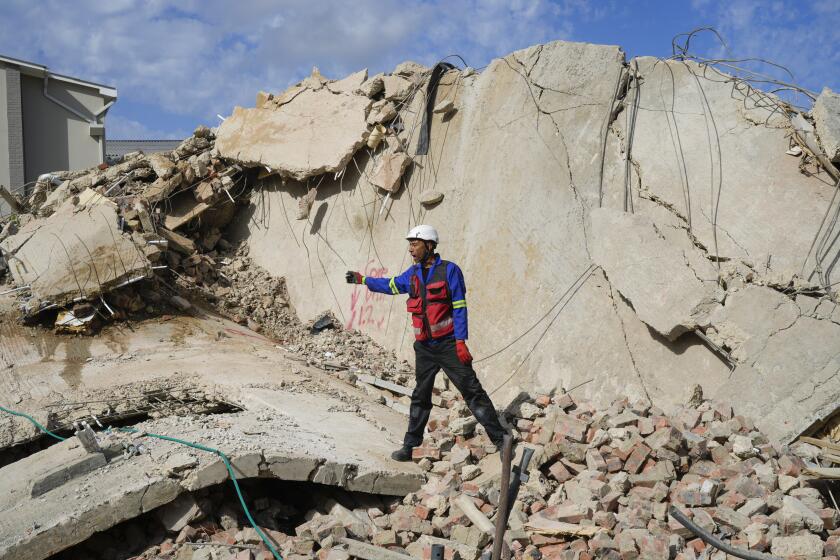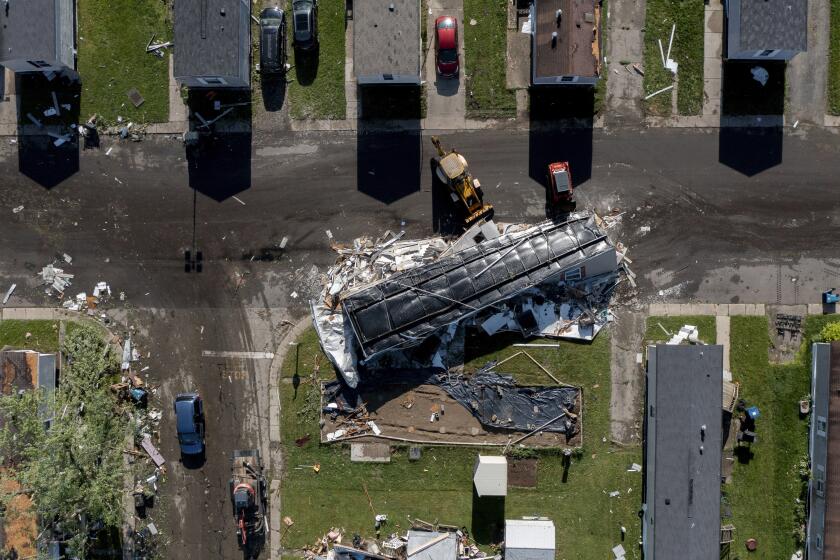On the nation’s last frontier, a battle over the last big newspaper
In what are supposed to be the dying days of paper and ink, and the rise of a new age of digital journalism, Alice Rogoff recently went out and bought herself a printing press.
If that sounds paradoxical, consider that she was the owner of a successful news website who, two years ago, went out and bought herself a newspaper.
After just seven years in the publishing business, what does she know that the doomsday experts don’t?
“I don’t see an end to print,” said the spare and scrappy publisher of the Alaska Dispatch News, the largest daily paper on the Last Frontier. “If I could see it, I would be preparing for it. We’re not.”
Being married to a billionaire may help. And surviving a plane crash doesn’t seem to hurt. Heading to a birthday party this week, Rogoff crashed the Cessna she’s known for piloting around the state into a cove near Homer — but swam away without injury.
If she can survive that, surely she can survive an industry that is losing altitude in terms of revenue, circulation and workers.
The current business model of most newspapers is to shed employees while shifting from a paid product thrown on doorsteps to a mostly free commodity delivered 24/7 from cyberspace — then try to make it pencil out.
For some, that’s been a blueprint for failure. According to a report last month by the Pew Research Center, there were 126 fewer daily papers as of 2014 than there were in 2004, and the industry workforce has shrunk by about 20,000 positions, or 39%, over the last two decades.
Alaska was at the forefront of that trend. The conservative, pro-business and mismanaged Anchorage Times was shuttered in 1992, forced to its knees after 77 years by its aggressive rival, the Anchorage Daily News, owned by the Sacramento-based McClatchy Co.
That left Anchorage a one-paper town. Then the News disappeared two years ago, in name at least, when Rogoff bought it for $34 million. She simultaneously merged the newspaper with a feisty news website she’d bought up earlier, Alaska Dispatch, and announced plans to expand the combined operation’s news and advertising footprint across the wide expanse of the 49th state.
But the new enterprise lost $3 million last year, according to one source familiar with its operations, and Rogoff has found herself caught up in at least two lawsuits — one she recently settled with McClatchy, whom she claimed underestimated the paper’s liabilities when it sold her the Daily News, and one with her former business partner, veteran journalist Tony Hopfinger.
Hopfinger claims that Rogoff breached a $1-million contract they’d sketched out on the back of a cocktail napkin in 2014 that promised him a generous exit if their grand news enterprise didn’t work out as planned.
“You should show this [napkin] to the judge if I don’t ever pay you,” Hopfinger said Rogoff told him that day.
+++
Rogoff in her former life — the one she had before she started keeping a bolt-action, high-power rifle propped up against the wall of her living room — was as an East Coast publishing executive. She was former chief financial officer for U.S. News and World Report, one of the architects of the Washington Post’s former weekly national edition and a senior assistant at the Office of Management and Budget in the Carter administration.
She raised three children with her husband, David Rubenstein, co-founder of the Carlyle Group, one of the largest private equity and alternative assets management groups in the world. With a personal net worth of $2.5 billion, according to Forbes, Rubenstein is one of the country’s richest men — though Rogoff insists that he hasn’t, thus far, invested in the newspaper.
Rogoff was smitten with Alaska during a barnstorming tour of the state in 2001, and eventually decided to give up Washington power parties to hunt moose, explore the Arctic and fly her own plane, often ferrying her own reporters and photographers to cover news in the state’s most remote corners.
Newsweek writer Josh Saul, who worked for Rogoff during her early days in the news business in Alaska, sees her as the “Katherine Graham of the North,” a reference to the late, longtime publisher of the Washington Post.
Rogoff came to Alaska “out of curiosity,” she said, then moved here out of convenience, tiring of the long flights back and forth to the state she’d decided to adopt.
Balanced on the edge of Cook Inlet, Anchorage “is a place like no other,” Rogoff said, and it’s hard to disagree. That night, the surrounding snow-capped mountains would be bathed in a pink, 2 a.m. sunset.
Her house, a stately, three-story, 4,000-square-foot lakeside abode in south Anchorage, was where President Obama retreated for dinner in September when he made his first visit to the state to spotlight the threat of climate change.
Shortly after buying the Dispatch website in 2009 from Hopfinger and his co-founder wife, Amanda Coyne, Rogoff kept Hopfinger on as editor and set up the newsroom at an airplane hangar at Merrill Field, near where she parked her Cessna 206.
“We all got along with Alice really well,” Hopfinger said. As he wrote in a 2012 column, outlining the site’s cage-rattling coverage of oil barons and political royalty, “Not once has Alice ever interfered in our decisions in the newsroom.” There were no sacred cows, though critics say she’s since become too cozy with several politicians, including independent Gov. Bill Walker.
The personal conflicts between the publisher and editor began in 2014, when Rogoff purchased the Daily News — a paper whose circulation had declined from a high of 100,000 to a little more than 41,000. “It was my belief, and others’ too, that it was financially risky to buy a newspaper when you had a solid business online,” Hopfinger said. “Alice talked about bringing in investors, local wheeler-dealers, to back her effort, which I saw as a journalistic conflict of interest.”
Rogoff eventually opted to keep the paper investor-free, but Hopfinger had decided he wanted out.
In his suit, filed last month, Hopfinger alleges that Rogoff wrote out on the cocktail napkin a pledge to pay him $1 million over a 10-year period. The agreement was later legally memorialized, and Hopfinger received the first of the 10 promised $100,000 payments in January 2015. But the publisher began backtracking, he claims, saying payments to him were dependent on a $12-million bridge loan she hoped to get.
It came down to a heated exchange in a parking lot outside the paper, in which Hopfinger admits he used some rough language. Not long after, he decamped for Chicago. He claims he was fired and had to go care for his ailing mother. Rogoff says he quit and left her with no one to run her suddenly expanded paper.
“When you scream at your boss and use expletives and then leave the state,” said a statement from Rogoff’s attorney, David Karl Gross, “I think any normal person is going to understand that that means quitting your job.”
Said Hopfinger: “I absolutely lived up to my promises. I did lose my cool at one point, and I regret that, but there was no screaming. She somehow thinks I was going to work for her for 10 years, it appears, but that was never part of the agreement.”
Is Rogoff feeling any pressure from all this? It’s not apparent. “I love my life,” she said, leaning back in her office chair.
She admits she’s taken inspiration from billionaire Jeff Bezos, owner and publisher of the Washington Post, whose successful business strategy at Amazon.com was to operate without a profit while growing the company.
Rogoff recently quoted Bezos in a column about her paper’s future. Like him, she was “in an investment mode,” she wrote. Her paper is “driven by more than the bottom line; we aim to connect Alaska, in more and better ways, both around the state and to ever-larger audiences.”
The new printing press, Rogoff said, is a stake in her plans to publish a newspaper here “for years, and perhaps decades to come.”
“The industry’s unsure what to expect from readers and their habits, and everyone’s working on a formula,” she said. “No one has an answer yet to ultimately saving print journalism. Our basic notion is that we will keep going because we have to.”
More to Read
Start your day right
Sign up for Essential California for news, features and recommendations from the L.A. Times and beyond in your inbox six days a week.
You may occasionally receive promotional content from the Los Angeles Times.






